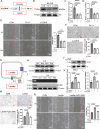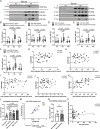Histone lactylation promotes rheumatoid arthritis progression by increasing NFATc2 expression and the production of anti-lactylated histone autoantibodies
- PMID: 41073397
- PMCID: PMC12514170
- DOI: 10.1038/s41467-025-64096-5
Histone lactylation promotes rheumatoid arthritis progression by increasing NFATc2 expression and the production of anti-lactylated histone autoantibodies
Abstract
Elevated lactate in the joint microenvironment of rheumatoid arthritis patients is crucial for disease progression, though the mechanism remains unclear. This study shows significantly increased global lactylation levels within fibroblast-like synoviocytes from RA patients compared to healthy controls, with lactylated proteins being enriched in histones. Furthermore, we find anti-lactylated histone autoantibodies present in RA patients that positively correlate with Disease Activity Score 28. Using CUT&Tag and RNA-seq, we identify NFATc2 as a key target gene regulated by histone H3 lysine 9 lactylation. Functional studies reveal that NFATc2 promotes migration of RA-FLSs. Additionally, using collagen antibody-induced arthritis and collagen-induced arthritis mouse models, we demonstrate that NFATc2 exacerbates RA disease progression through enhancing the cartilage invasive function of FLS. Here, we show that upregulated target gene NFATc2 by lactate-dependent histone lactylation, can be used as a potential therapeutic target for intervention, anti-lactylated histone autoantibodies is promising as a diagnostic marker for RA.
© 2025. The Author(s).
Conflict of interest statement
Competing interests: The authors declare no competing interests.
Figures






References
-
- Smolen, J. S. et al. Rheumatoid arthritis. Nat. Rev. Dis. Prim.4, 18001 (2018). - PubMed
-
- Komatsu, N. & Takayanagi, H. Mechanisms of joint destruction in rheumatoid arthritis - immune cell-fibroblast-bone interactions. Nat. Rev. Rheumatol.18, 415–429 (2022). - PubMed
-
- McInnes, I. B. & Schett, G. Pathogenetic insights from the treatment of rheumatoid arthritis. Lancet389, 2328–2337 (2017). - PubMed
-
- Orr, C. et al. Synovial tissue research: a state-of-the-art review. Nat. Rev. Rheumatol.13, 463–475 (2017). - PubMed
MeSH terms
Substances
Grants and funding
LinkOut - more resources
Full Text Sources

